|
Temple of Laughter Represents Tragedy and Comedy
by Russell Boniface
Associate Editor
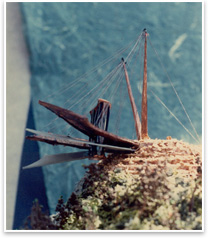 Summary: Randal Jay Ehm, AIA, president and CEO of Ehm Architecture Inc. in San Diego, has designed a cantilevered, cable-stayed structure called the Temple of Laughter that perhaps one day will be sited on a hillside in Hollywood, although the temple could be sited anywhere. The concept emerged from an international design competition called “The Laugh” sponsored by a group called The End that sought designs to represent laughter through a “gravity-defying” structure. Says Ehm, “The sponsor wanted the structure to defy gravity because laughter is uplifting and involves levity.” Ehm’s theme honors the relationship between tragedy and comedy. He thought Hollywood would be a suitable location, since it is home to the entertainment industry. The temple would feature “holograms” of living and recently deceased comedians to represent the duality of comedy and tragedy. His design won a Technical Achievement Award from AIA San Diego. Summary: Randal Jay Ehm, AIA, president and CEO of Ehm Architecture Inc. in San Diego, has designed a cantilevered, cable-stayed structure called the Temple of Laughter that perhaps one day will be sited on a hillside in Hollywood, although the temple could be sited anywhere. The concept emerged from an international design competition called “The Laugh” sponsored by a group called The End that sought designs to represent laughter through a “gravity-defying” structure. Says Ehm, “The sponsor wanted the structure to defy gravity because laughter is uplifting and involves levity.” Ehm’s theme honors the relationship between tragedy and comedy. He thought Hollywood would be a suitable location, since it is home to the entertainment industry. The temple would feature “holograms” of living and recently deceased comedians to represent the duality of comedy and tragedy. His design won a Technical Achievement Award from AIA San Diego.
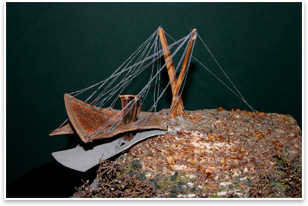 “I laugh because I must not cry." “I laugh because I must not cry."
—Abraham Lincoln
The premise of the design competition by The End was to develop a Temple of Laughter. Although the group budgeted $100,000 to develop the winning proposal, Ehm’s own estimate for his Temple of Laughter is $5 million. Ehm says that the Shakespearean masks of tragedy and comedy inspired his temple design. “I did a lot of research into laughing and found out that with Shakespeare, philosophers, sociologists, and Abraham Lincoln, the common thread was you laugh so you won’t cry.”
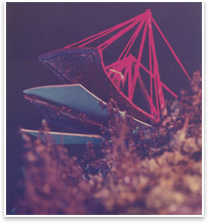 Tragedy and comedy; paradox and dichotomy Tragedy and comedy; paradox and dichotomy
The Temple of Laughter appears to defy gravity as criteria for the completion. This is meant as a metaphor for comedy as levity. “The concept of levity is part of laughter,” Ehm says. But he wanted to add the duality of tragedy and comedy--what he calls paradox and dichotomy.
The structure would feature observation platforms cantilevered into a hillside, with shade screens above them. The shade screens would be supported above on a hilltop by masts and cables, Although it appears the masts and cables support the entire structure, they would only support these screen, an illusion that to Ehm is a paradox.
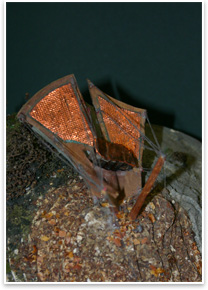 “The punch line of a joke is often a paradox—something that is seemingly so but is impossible or ridiculous,” Ehm explains. “The temple appears to be defying gravity, but the structure is actually cantilevered into the hillside, representing a paradox.” He adds that a paradox also takes place when lasers activate at night shielding the support cables, giving the appearance that the lasers are supporting the entire structure. “The punch line of a joke is often a paradox—something that is seemingly so but is impossible or ridiculous,” Ehm explains. “The temple appears to be defying gravity, but the structure is actually cantilevered into the hillside, representing a paradox.” He adds that a paradox also takes place when lasers activate at night shielding the support cables, giving the appearance that the lasers are supporting the entire structure.
Dichotomy also represents more irony in this project, he notes, such as is represented with the site choice. “The west half of the site landscape represents tragedy with a barren rock environment, while the east side represents comedy through a lush, forested landscape.”
The landscape, however, would feature tree stumps and fallen trees to represent the inevitability of death. Conversely, a shrub that would have presumably sprung to life as a seedling from a dead tree would represent regeneration from death.
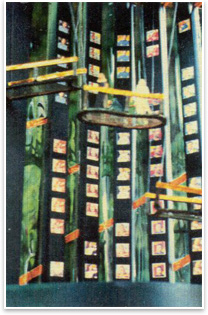 Comedians on a levitating, rotating platform Comedians on a levitating, rotating platform
A gangway would lead to a levitating, rotating platform where there would be a circular group of tall columns showing monitors projecting holograms of recently deceased comedians, such as George Carlin and Bernie Mac, performing their comedy. An outside laser would activate a video monitor to create the holograms. “The holograms of recently deceased comedians represent tragedy,” Ehm points out. The platform would rotate and levitate using small magnetic charges as an axis. “I went to scientists at the University of California San Diego. They actually thought it could work.”
The viewing platform would rise as the holograms play upward in a spiral pattern. Then, at the halfway point upward, holograms of living comedians would perform. At the apex, all hologram monitors would shut off. Concludes Ehm, “People are then left on the platform with their own laughter.” |



